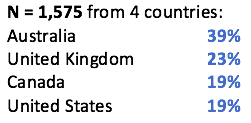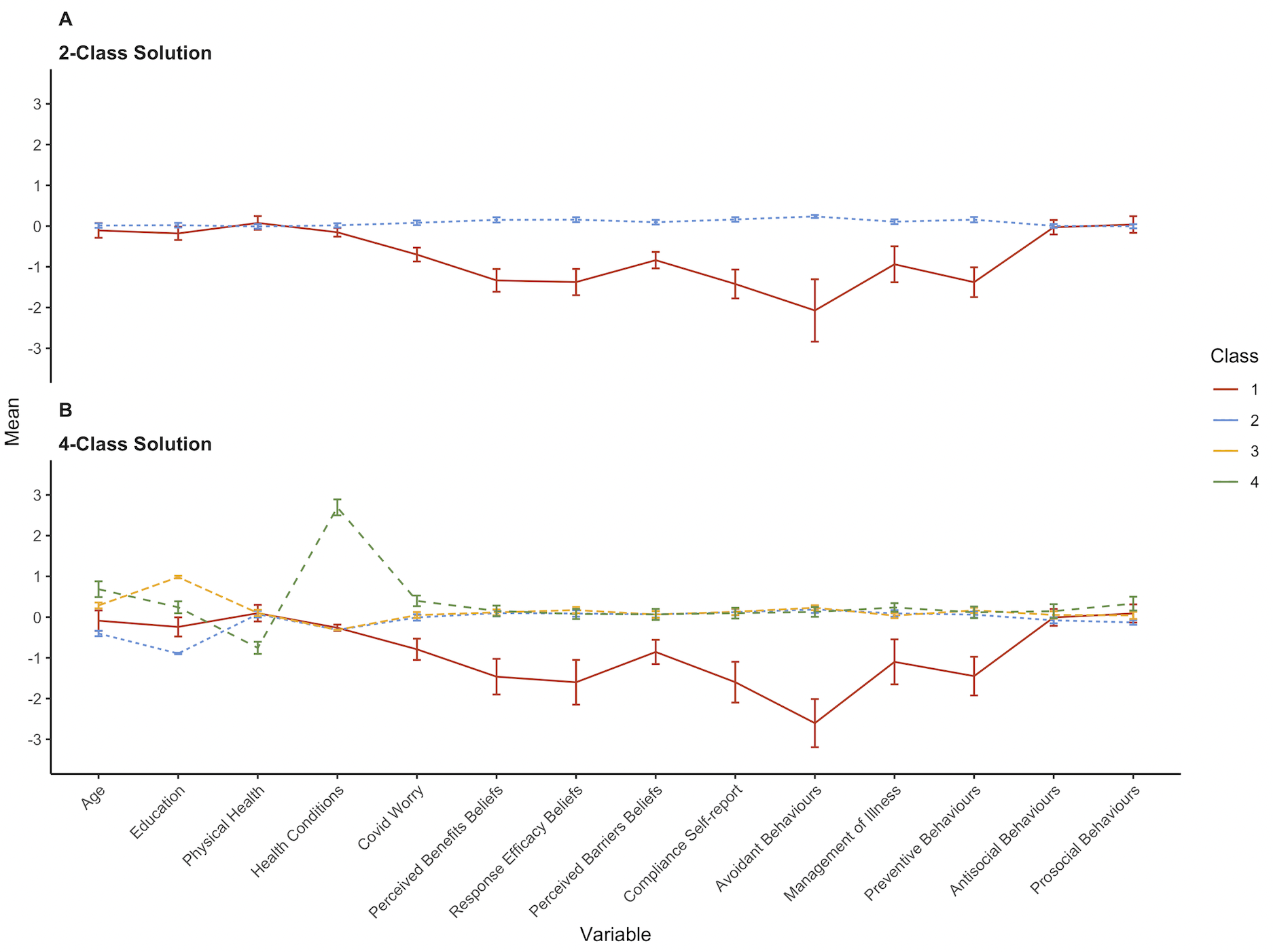To Comply or Not Comply?
To Comply or Not Comply? A Latent Profile Analysis of Behaviours and Attitudes During the COVID-19 Pandemic
Read the study! →
Read the USYD Media Release→
Background:
This study sought to examine the characteristics of those who comply with behavioural rules and recommendations implemented during COVID-19, and those who do not.
We looked at three types of protective behaviours:
(1) Avoidant Behaviour (e.g. social distancing)
(2) Management of Illness (e.g. seeking medical advice if you have symptoms)
(3) Preventive (e.g. hygiene, hand-washing)
Participants and Design:

Firstly, we used Latent Profile Analysis to identify subgroups within the sample who share similarities based on:
- COVID-19 protective behaviours (Avoidant, Management, Preventive)
- Antisocial (e.g. hoarding, verbal or physical altercations) and Prosocial (e.g. donating, offering support to those in need) behaviours
- Beliefs about COVID-19 protective measures:
- Response Efficacy Beliefs (i.e. protective measures are effective in reducing the spread)
- Perceived Benefits Beliefs (i.e. protective measures are beneficial and thus accepted)
- Perceived Barriers Beliefs (i.e. protective measures are inconvenient and costly)
- Key Demographics
- Age, education level, physical health level, and pre-existing health conditions
Secondly, we looked at differences between the groups who scored high on protective behaviours (i.e. compliant people) and those who scored low (i.e. non-compliant people), on a comprehensive selection of factors including:
- Big 5 Personality: Extraversion, Agreeableness, Conscientiousness, Neuroticism, Intellect/Openness
- Resilience/Adaptability
- Strategies for coping with COVID-19 related challenges
- Political and cultural factors: Conservatism, Right-Wing Authoritarianism, Cultural Tightness-Looseness
- Media use and trust in information sources
- Anticipated future reasons for leaving home
Results:
We found support for two and four profile solutions in the data.
Note. Perceived Barriers Beliefs was reverse scored.
Two Class Solution:
Class 1 (‘non-compliant’) comprised 10% of the sample, scoring lower on all 3 types of protective behaviours, beliefs, self-reported compliance, and worry.
Class 2 (‘compliant)’ comprised 90% of the sample.
The groups did not differ on any of the demographics.
Four Class Solution:
In the four class solution, the large compliant group split into three separate groups which differed on demographics:
Class 1 (‘non-compliant’) comprised 7%, and were lower than all other groups on all protective behaviours, beliefs, worry, and compliance (mean age = 29).
Class 2 (‘young and compliant’) comprised 43% of the sample and were younger than all other groups (mean age = 25).
Class 3 (‘educated and compliant’) comprised 40% and were the most highly educated group (mean age = 34).
Class 4 (‘vulnerable and compliant’) comprised 10%, were the oldest group and had poorer physical health and more pre-existing health conditions than other groups (mean age = 40).
The two class solution was used for all subsequent analyses.
Did compliance rates differ between countries?
America had the lowest compliance rate of 82%, Australia was 88% compliant, and Canada and the UK both had 94% in the compliant group.
Were there any gender differences?
92% of females were compliant, compared to 86% of males.
What were the main differences between the compliant group and the non-compliant group?
Personality:
The non-compliant group were less agreeable, lower on intellect/openness, and more extraverted.
Coping Strategies:
Compliant people were more likely to cope with COVID-19 through self-distraction, active strategies, and planning.
Non-compliant people were more likely to cope through denial, substance use, and behavioural disengagement.
Information Consumption:
The non-compliant group checked the news and the legitimacy of sources less. They also reported lower trust in information sources.
Compliant people used official information sources such as government and health authority websites more.
Political and Cultural:
The non-compliant group rated the government as being less truthful and rated their culture as looser (less accustomed to strict social norms, higher value on individual freedom). They were also higher on reactance and amorality.
Reasons for Leaving Home:
Non-compliant people were more likely to report the following reasons for leaving their home in the next week:
‘Essential’ reasons:
- Going to work
- Physical activity
- To get food
- To care for dependants
‘Non-essential’ reasons:
- To meet friends or family
- Religious reasons
- Because they are bored of being at home
- To exercise their right to freedom
Both the non-compliant and compliant groups were equally likely to leave home to walk a pet, go to the pharmacy, or get medical treatment.
Key Take-Aways:
- Compliant and non-compliant individuals hold different beliefs about the efficacy, benefits, and costs of protective measures.
- The non-compliant group was not made up simply of young people, contrary to the oft-promoted media stereotype of the COVID-indifferent young people ignoring restrictions.
- Compliant people reported greater use of official government and health information sources than non-compliant, suggesting they are better-informed about COVID-19.
- Compliant people also trusted information sources more than non-compliant, which may be associated with greater worry, in turn promoting compliance.
- Compliant people perceived the government as being more truthful than non-compliant.
- However, the compliant group were also more likely to perceive the government’s response as being insufficient, which may be associated with greater worry, which motivates compliance.
- Non-compliant people scored higher on amorality, indicating they driven by self-interest.
Publication:
Kleitman, S., Fullerton, D. J., Zhang, L. M., Blanchard, M. D., Lee, J., Stankov, L., & Thompson, V. (2021). To comply or not comply? A latent profile analysis of behaviours and attitudes during the COVID-19. PLOS One, 16(7), e0255268. https://doi.org/10.1371/journal.pone.0255268
Press:
University of Sydney Press Release, 30 July 2021 ‘What psychology says about COVID non-compliers’
ABC Radio National Drive, 30 July 2021 ‘Who makes up the 10 per cent that don’t comply with covid restrictions?’
The Guardian, 31 July 2021 ‘Extroverted, self-centred men less likely to comply with Covid restrictions, study suggests’
Medical Xpress, 31 July 2021 ‘COVID noncompliers less open to new ideas, and more extroverted and driven by self-interests’
The Greater India, 31 July 2021 ‘Extroverted, egocentric males most probably to disregard COVID-19 rules, research finds’
MSN New Zealand, 2 August 2021 ‘Selfish male extroverts more likely to defy Covid restrictions, study says’
News Corp Australia, 3 August 2021 ‘Study shows the traits that Covid rule breakers share’
The Australian, 3 August 2021 ‘Research finds most likely people to breach Covid-19 restrictions not young’
Cosmos Magazine, 4 August 2021 ‘The psychology of COVID compliance’
More available upon request.


